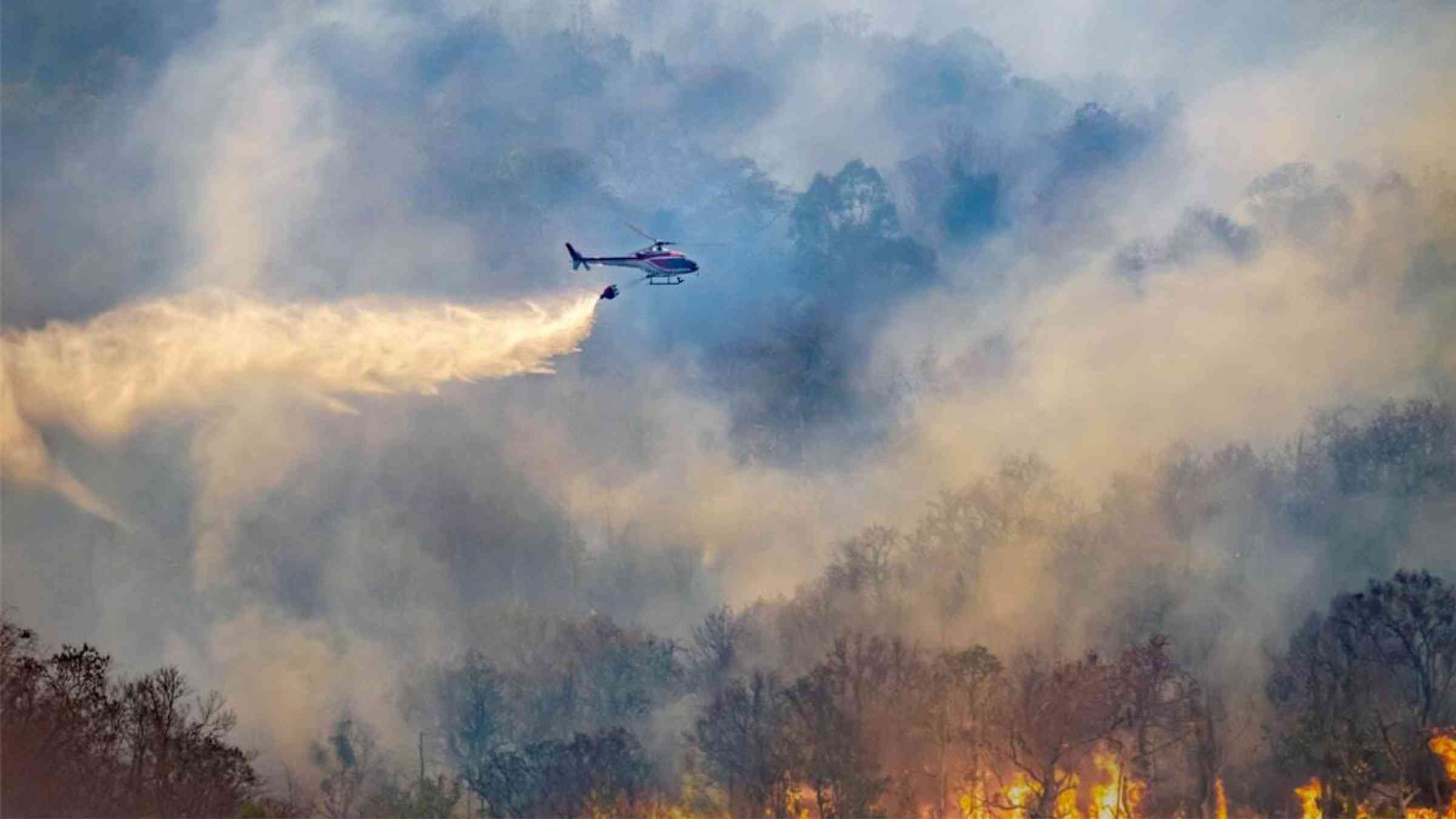Extreme wildfires make their own weather

Extreme fires in the western United States and Southeast Asia influenced the local weather in ways that make fires and smoke pollution worse.
The wrong kind of weather can turn a manageable wildfire into an uncontrollable blaze. In California, Santa Ana winds notoriously fan flames with streams of hot, dry air, and Europe’s 2022 summer of record-breaking heat was also a summer of record-breaking fires. But it isn’t just weather that influences fires—fires can influence weather, too.
New research has suggested that smoke from particularly large blazes can change local weather, making fires even worse. This could be bad news for fire-prone regions experiencing more frequent fires due to climate change. But the study, published in Science, also hinted that building fire-weather interactions into weather forecasts could help direct firefighting resources to where they’ll be most effective.
“Wildfires are not just a consequence of climate change or global warming,” said study coauthor and atmospheric scientist Xin Huang of Nanjing University in China. “They’re also an active participant.”
Fire Weather
There’s bad weather, and then there’s fire weather. High temperatures, dry air, and strong winds all can make it easier for fire to spark and spread. Wind also can carry smoke great distances, as it did in 2020 when fires in California, Oregon, and Washington tinted the skies across the continent with a reddish haze.
Fire weather is short-term, occurring over days, weeks, or months. But changes in climate—average, long-term patterns in temperature and weather—are making severe fire weather more likely in some fire-prone regions.
“Conditions that lead to fires are becoming more and more frequent into the future because the climate is warming,” said climate scientist Danielle Touma of the National Center for Atmospheric Research and Colorado State University who was not involved in the study. Drier conditions associated with climate change in some regions also contribute to fires.
“In existing studies, we usually focus on the long-term [climatic] variations in wildfires,” said Huang. But shorter-term interactions between fire and weather aren’t well understood, even though anomalous fire weather conditions are often clearly involved in extreme fires. That’s a problem, Huang said, because “extremely large fire events are the most catastrophic ones, causing very large loss of life.”
Smoke Screens Affect Temperature
The research team used computer models to simulate how weather interacts with smoke from wildfires over days and weeks during two extreme fire events that occurred in fire-prone regions: the September 2020 “gigafire” in the western United States and the 2004 fire season in Southeast Asia. The scientists based the simulations on surface meteorological and air quality measurements and satellite observations of thermal anomalies, aerosols, and the surface area burned by the fires each day.
In both cases, fire smoke contributed to short-term weather patterns that intensified fires and worsened fire-driven air pollution—one of the main ways fires threaten human health. However, “the driving factors are quite different” in the two regions, said study coauthor and atmospheric scientist Aijun Ding of Nanjing University.
On the U.S. West Coast, fire smoke blocked sunlight, causing the land beneath the smoke to cool. This cooling sped up easterly winds carrying dry air from the land toward the sea, lowering humidity by trapping moisture offshore and helping fires spread. In Southeast Asia, wildfire smoke shadowed the land and warmed the air higher in the atmosphere where smoke particles absorbed incoming sunlight. Water cools more slowly than land, so this shading effect caused the ground to cool relative to the warming air over the sea, feeding a cyclone system off the coast that interfered with the normal monsoon rains and left the land parched and flammable.
Taken together, the results showed how fires can create positive feedback loops that intensify fire weather conditions, which in turn intensify fires. “I think this study is really important because it uncovers some of the processes that underlie those feedbacks,” Touma said.
Climate Connection
The study showed how including chemical weather, such as smoke conditions, in weather forecasting models could improve forecasts of fire weather, Ding said. And some locations seem to have stronger fire-weather feedbacks than others, so identifying these “amplifying regions” early in a fire could help direct firefighting resources to where they’ll be most effective.
“In this way, with the same cost of the firefighting resources, we can maximize our disaster mitigation,” Huang said. Finding ways to use these kinds of models in practice will depend “on faster progress on supercomputers and simulations coupling weather and climate and fire behavior,” she added.
In addition, the same climate trends that are making extreme fires more frequent could interact with climate-weather feedbacks like the ones described in the new study. “It’d be interesting to understand what this means under future climate change,” Touma said. For instance, she suggested, future studies could test how fire-weather feedbacks change if the temperature is 1°C or 2°C hotter on average.
“We really need to understand these processes,” Touma said. Climate change is making fire weather more likely, and it’s clear now that fires can create their own fire weather, too, leading to more extreme events and setting the stage for future blazes. “If we have more and more of these fires, then we will possibly see more and more of these impacts.”